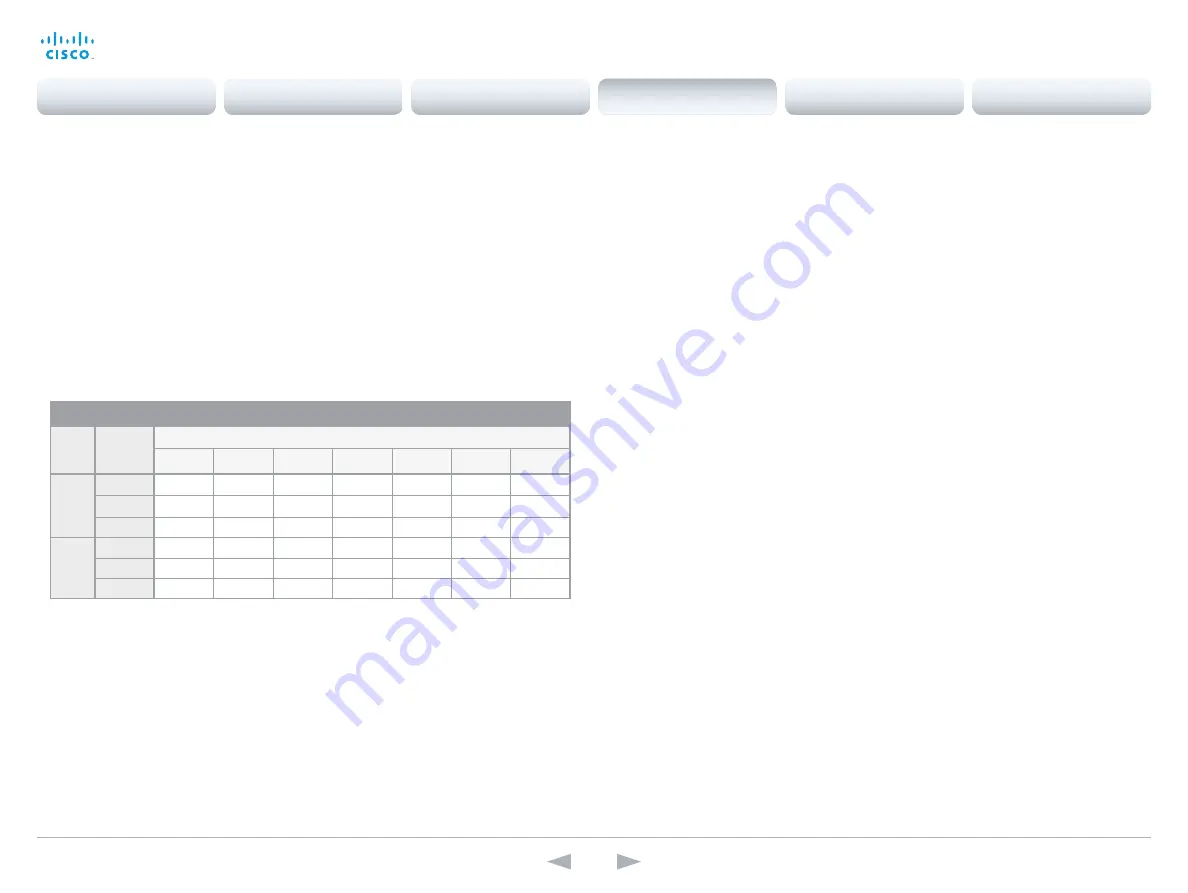
D14850.12 MX200 and MX300 Administrator Guide TC7.3, JULY 2015.
www.cisco.com — Copyright © 2011–2015 Cisco Systems, Inc. All rights reserved.
105
Cisco TelePresence MX200 and MX300
Administrator Guide
Video Input Source [1..2] OptimalDefinition Profile
The Video Input Source Quality setting must be set to Motion for the optimal definition settings
to take any effect.
The optimal definition profile should reflect the lighting conditions in your room and the quality
of the video input (camera); the better the lighting conditions and video input, the higher the
profile. Then, in good lighting conditions, the video encoder will provide better quality (higher
resolution or frame rate) for a given call rate.
Generally, we recommend using the Normal or Medium profiles. However, when the lighting
conditions are good, the High profile can be set in order to increase the resolution for a given
call rate.
Some typical resolutions used for different optimal definition profiles, call rates and transmit
frame rates are shown in the table below. It is assumed that dual video is not used. The
resolution must be supported by both the calling and called systems.
Use the Video Input Source OptimalDefinition Threshold60fps setting to decide when to use the
60 fps frame rate.
.
Requires user role:
ADMIN
Value space:
<Normal/Medium/High>
Normal:
Use this profile for a normally to poorly lit environment. Resolutions will be set rather
conservative.
Medium:
Requires good and stable lighting conditions and a good quality video input. For
some call rates this leads to higher resolution.
High:
Requires nearly optimal video conferencing lighting conditions and a good quality video
input in order to achieve a good overall experience. Rather high resolutions will be used.
Example:
Video Input Source 2 OptimalDefinition Profile: Normal
Video Input Source [1..2] OptimalDefinition Threshold60fps
For each video input, this setting tells the system the lowest resolution where it should transmit
60 fps. So for all resolutions lower than this, the maximum transmitted frame rate would be
30 fps, while above this resolution 60 fps will also be possible, if the available bandwidth is
adequate.
Requires user role:
ADMIN
Value space:
<512_288/768_448/1024_576/1280_720/1920_1080/Never>
512_288:
Set the threshold to 512x288.
768_448:
Set the threshold to 768x448.
1024_576:
Set the threshold to 1024x576.
1280_720:
Set the threshold to 1280x720.
1920_1080:
Set the threshold to 1920x1080.
Never:
Do not set a threshold for transmitting 60fps.
Example:
Video Input Source 2 OptimalDefinition Threshold60fps: 1280 _ 720
Video Input Source [1..2] Quality
When encoding and transmitting video there will be a trade-off between high resolution and
high frame rate. For some video sources it is more important to transmit high frame rate than
high resolution and vice versa. The Quality setting specifies whether to give priority to high
frame rate or to high resolution for a given source.
Priority is always given to high frame rate for the video system's internal camera, therefore
Quality is fixed to Motion for
Input Source 2.
Requires user role:
ADMIN
Value space:
<Motion/Sharpness>
Motion:
Gives the highest possible frame rate. Used when there is a need for higher frame
rates, typically when a large number of participants are present or when there is a lot of
motion in the picture.
Sharpness:
Gives the highest possible resolution. Used when you want the highest quality of
detailed images and graphics.
Example:
Video Input Source 2 Quality: Motion
Typical resolutions used for different optimal definition profiles, call rates and frame rates
Frame
rate
Optimal
Definition
Profile
Call rate
256 kbps
768 kbps 1152 kbps 1472 kbps 2560 kbps
4 Mbps
6 Mbps
30 fps
Normal
512 × 288
1024 × 576 1280 × 720 1280 × 720 1920 × 1080 1920 × 1080 1920 × 1080
Medium
640 × 360
1280 × 720 1280 × 720 1280 × 720 1920 × 1080 1920 × 1080 1920 × 1080
High
768 × 448
1280 × 720 1280 × 720 1920 × 1080 1920 × 1080 1920 × 1080 1920 × 1080
60 fps
Normal
256 × 144
512 × 288
768 × 448
1024 × 576 1280 × 720 1280 × 720 1280 × 720
Medium
256 × 144
768 × 448
1024 × 576 1024 × 576 1280 × 720 1280 × 720 1280 × 720
High
512 × 288
1024 × 576 1280 × 720 1280 × 720 1280 × 720 1280 × 720 1280 × 720
Contents
Introduction
System settings
Setting passwords
Appendices
Web interface
System settings
















































